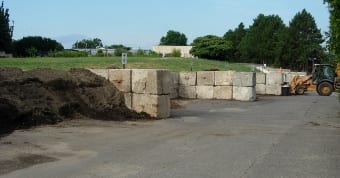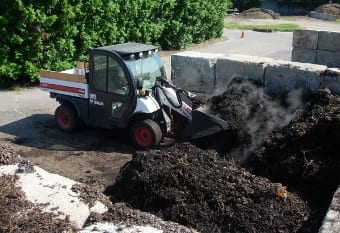by Paul Kwiatkowski
Mount Auburn is not only America’s first garden cemetery, but an arboretum with more than 6,000 trees from around the globe. For those of you who have had the opportunity to visit and explore the grounds, I hope you were so entranced by the trees, gardens, monuments, and wildlife that many return visits have been required. Those of you who have not discovered Mount Auburn yet, I hope you visit soon.
We strive whenever and wherever we can to improve how we maintain our 175-acre institution. In 2004, we began collecting rainwater for irrigation to reduce our water consumption and limit the storm water impact on our drainage system. Today, we are experimenting with propane as an alternative fuel to power a portion of our lawnmower fleet. But one of our greatest concerns has been what do we do with the waste generated by our grounds maintenance. We would rather not need to have material hauled off site. It makes much more sense to reuse material and become a net zero waste facility.
Steps Toward Zero Waste
On this front, we have made great strides over the past several years. We allocated a portion of our property to become a recycling center. In this area, we constructed a series of bins to hold grounds waste, pea stone, sand, gravel, asphalt, concrete, interment fill, compost, loam, hard and softwood, as well as paper, cardboard, glass and plastic recycling. We are also able to store woodchips from arbor work on our tree collection, leaves, and mulch. The mulch is made on site by double grinding aged leaves and woodchips. This initiative is important because we no longer need to buy mulch, and we are reducing waste.
Compost creation has been the single biggest adjustment we have made towards our goal of zero waste, and its ripple effects are felt in many ways. For example, we can use finished compost to amend soil in order to improve grass seed germination. Gardens and turf can be top-dressed to enhance the biological diversity and activity in the soil, reducing fertilizer and irrigation requirements. Radial trenching can be performed within the drip zone of a stressed tree’s canopy to again improve diversity and activity of the biology in the root zone. To prevent erosion on slopes, we utilize compost filter socks that can be directly planted in. Potting mix, made at our greenhouse, reduces the amounts of purchased potting mix and fertilizers and also reduces our water consumption. Finally, we can make compost tea for foliar applications and soil drenches on young ornamental trees to protect them from pests and diseases and to stimulate growth.
Composting Considerations
The composting process is not difficult. However, it is important to be aware of several factors.
Pile size: Most people will make compost by pile or windrow. Compost windrows usually are much larger in scale and used in commercial production or large agriculture. At Mount Auburn, we use the pile method. The pile should always be a manageable size. When using an earth mover, such as a front-end loader or back hoe, the pile should be no more than eight feet high to ensure that the pile can be easily and safely turned. A backyard gardener should keep the pile within three to four feet tall when turning by hand.
Moisture: The compost pile should be damp, not wet or saturated with moisture. This provides a healthy environment for beneficial microbial development and prevents anaerobic bacteria from colonizing in the pile. There may be times during periods of drought when the pile needs to be watered by hand or sprinkler. In heavy precipitation periods, the pile may need to be covered with a tarp.
Aeration: The pile must be turned to keep the compost aerated for beneficial microorganisms to build healthy, diverse populations and to prevent anaerobic bacteria from developing in the pile.
Temperature: A compost pile must reach and maintain a temperature of 131 degrees Fahrenheit for three consecutive days to kill weed seed and pathogens that may have been in the feedstock. Windrows must maintain 131˚F for seven consecutive days.
Feedstock and recipe: To determine what you will need to make your compost, you must decide what you will use the compost for. A fungal recipe will consist of two parts carbon or brown material (dry leaves, woodchips, straw) and one part nitrogen or green material (grass clippings, coffee grounds, tea leaves, fresh shrub pruning). Fungal compost may be used for woodland plant material, such as trees, shrubs, groundcovers, and other woodland plants. A bacterial compost recipe will consist of two parts green material to one part brown and may be used for annuals, turf, vegetables, and many herbaceous garden perennials. In the recycling center, we have separate bins for green and brown feedstock and for fungal and bacterial compost mixes.
The Process
Once the recipe and feedstock has been decided upon, the composting process is ready to begin. The pile should be turned five times in the first 15 days upon establishment. Monitor temperature, aeration, and moisture. After 15 days, the pile can be turned less often as it will finish cooking and begin the cooling down period. The compost may be used when it reaches ambient temperature. Do not use unfinished compost as it may burn the roots of plants it is incorporated around. Finished compost will have a deep earthy color and aroma.
An institution most likely will want to screen the finished compost before using it on the grounds to remove larger material which may not have broken down as quickly as the majority of the pile. Most backyard gardeners can make do without screening by simply remove the largest material by hand.
Mount Auburn Cemetery makes 100 yards of compost every year and the subtraction of waste creates a healthy addition to our environment, while establishing a more efficient and dynamic grounds maintenance program.
About the Author
Paul Kwiatkowski is a Conservationist and Assistant Greenhouse Manager at Mount Auburn Cemetery in Cambridge, MA. He has worked on many landscape and aquatic restoration and habitat improvement projects over the past 14 years and is one of the architects of Mount Auburn’s sustainable reforms.




